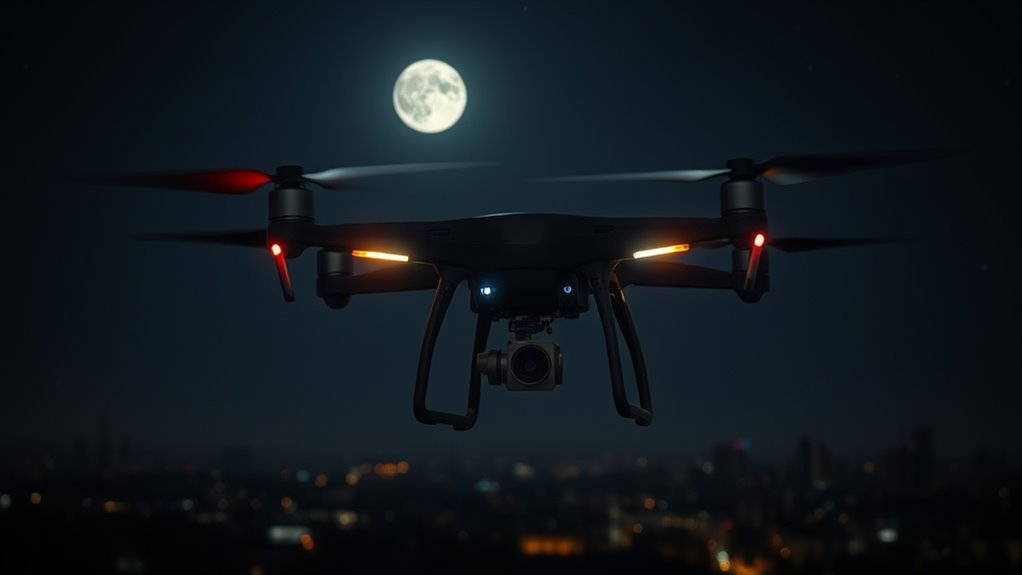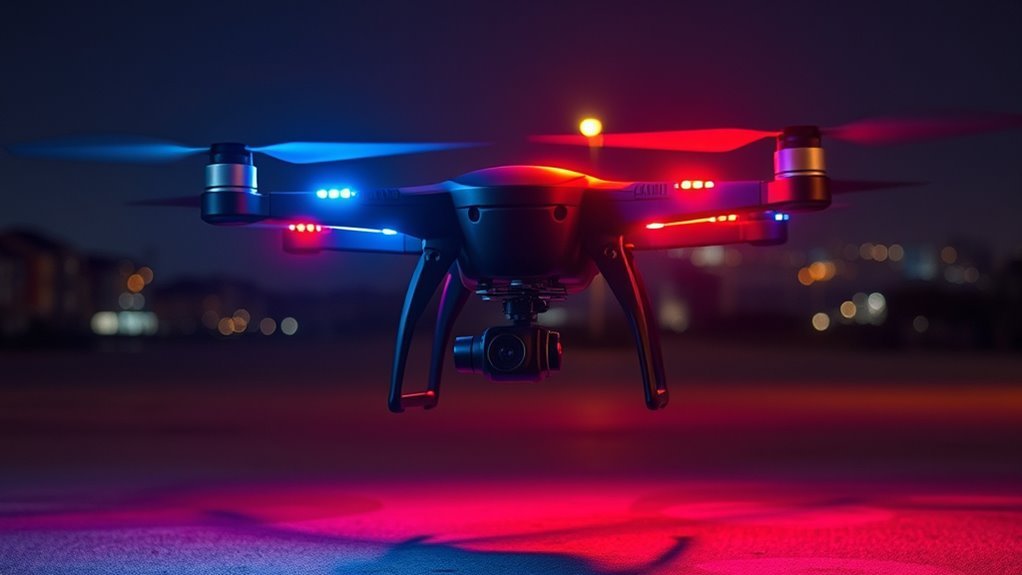Police drones at night utilize advanced night vision and thermal imaging technology, guaranteeing enhanced visibility in low-light conditions. They feature powerful LED spotlights that can adjust brightness for various situations. With stable flight capabilities and GPS accuracy, they maintain effectiveness during nighttime operations. Real-time data transmission allows for immediate communication with law enforcement. Enhanced surveillance capabilities guarantee swift incident response and improved community safety. Discover more about how these features shape nighttime operations and enhance policing.
Night Vision Technology

When it comes to enhancing police operations after dark, night vision technology plays a crucial role. By utilizing infrared sensors, these systems provide enhanced visibility, allowing officers to navigate and monitor situations with clarity. You’ll find that this technology captures light that’s invisible to the naked eye, translating it into a clearer image, even in complete darkness. With drones equipped with night vision capability, law enforcement can conduct surveillance, track suspects, and assess crime scenes more effectively. This freedom to operate under low-light conditions not only increases safety for officers but also helps maintain public security. By embracing night vision technology, police departments can enhance their operational efficiency and uphold community safety, reinforcing the principles of liberty and protection for all. Furthermore, the superior sensor sensitivity of Teal 2 allows for better performance in dim environments, ensuring reliable visibility during nighttime operations. Notably, the advanced thermal imaging system of the Teal 2 enables it to detect heat signatures up to 1.5 km away, providing a tactical advantage in various situations.
Thermal Imaging Capabilities

While night vision technology enhances visibility in low-light conditions, thermal imaging capabilities take police drone operations a step further by detecting heat signatures. These advanced thermal detection techniques allow officers to identify people, vehicles, or even hidden objects in complete darkness. With infrared sensor advancements, drones can produce clear images based on temperature differences, making them invaluable for search and rescue missions, surveillance, or tracking suspects. You’ll find that these tools empower law enforcement to operate more effectively while maintaining public safety. By leveraging thermal imaging, you’re not just gaining a tactical advantage; you’re also embracing a technology that enhances community protection and fosters a sense of freedom, ensuring that safety remains a priority for everyone involved. Additionally, the ability of drones to detect temperature variations with high precision enhances their effectiveness in critical situations. This capability of swift detection of heat signatures allows quicker identification of individuals and threats, further improving operational efficiency during emergencies.
LED Spotlight Features

Alongside thermal imaging, LED spotlight features considerably enhance police drone capabilities during nighttime operations. These spotlights provide adjustable LED brightness levels, allowing for ideal illumination tailored to the situation. You can switch between high, medium, and low brightness, ensuring visibility without overwhelming the scene.
Moreover, the versatility of spotlight angles plays an essential role. You can tilt and rotate the spotlight to focus on specific areas, whether you’re surveying a wide landscape or zeroing in on a suspect. This flexibility not only aids in surveillance but also enhances safety during critical operations. By utilizing advanced LED spotlight features, police drones become invaluable tools for maintaining order and ensuring public safety in the dark.
Flight Stability and Range
When you’re operating a police drone at night, flight stability and range are essential for effective monitoring. Factors like night vision capability, GPS accuracy, and wind resistance play significant roles in ensuring your drone remains steady and reaches the desired locations. Understanding these elements can enhance your mission’s success and improve overall operational efficiency. Additionally, advanced night vision capabilities can significantly improve the drone’s performance in low light conditions, allowing for clearer surveillance and monitoring. Furthermore, drones like the Draganfly X4-ES provide superior wind resistance, ensuring reliable operation even in challenging weather conditions.
Night Vision Capability
As night falls, the effectiveness of police drones heavily relies on their night vision capability, which greatly enhances flight stability and range. With the latest night vision advancements, these drones can navigate through the darkest environments, ensuring law enforcement maintains safety and security. Here’s how their low light performance impacts operations:
- Improved Target Detection: Enhanced image quality allows for clearer identification of potential threats.
- Extended Flight Time: Advanced battery management systems help sustain operations longer in low light conditions.
- Obstacle Avoidance: Superior sensors help drones maneuver around obstacles, maintaining stability even in challenging environments.
These features empower drones to operate effectively at night, ensuring freedom and safety for communities.
GPS Accuracy
GPS accuracy plays an essential role in enhancing the flight stability and range of police drones, particularly during night operations. When you’re relying on drone navigation in low-light conditions, precise GPS signals help maintain the drone’s intended flight path, ensuring it can effectively cover the area of interest. This accuracy not only maximizes the drone’s operational range but also minimizes the risk of losing control, which can be critical during urgent missions. A stable flight allows for better data collection, whether you’re monitoring a scene or searching for suspects. Ultimately, accurate GPS enhances your freedom to operate drones confidently at night, empowering law enforcement to serve and protect effectively, even in challenging environments.
Wind Resistance Factors
Although police drones are equipped with advanced technology, wind resistance remains a significant factor that can impact flight stability and range, especially during nighttime operations. Understanding how wind affects your drone is essential for effective usage. Here are three wind resistance factors to evaluate in drone design:
- Aerodynamics: The shape of the drone plays a critical role in how it cuts through the air, reducing drag and improving stability.
- Weight Distribution: A well-balanced drone can withstand gusts more effectively, maintaining its flight path and ensuring reliable performance.
- Propeller Design: Specialized propellers can help counteract wind effects, enhancing lift and overall efficiency during challenging conditions.
Data Transmission and Communication
Modern police drones rely heavily on advanced data transmission and communication technologies to operate effectively, especially during nighttime missions. With the need for secure and reliable communication, data encryption is vital to protect sensitive information. You’ll find that maintaining strong signal strength is fundamental for uninterrupted operations, allowing officers to receive real-time data without delays. The potential for increased competition in the drone market may lead to innovations in data encryption technologies, enhancing the security of police communications. Furthermore, the implementation of user control over flight data ensures that sensitive information remains private and accessible only to authorized personnel.
| Feature | Importance |
|---|---|
| Data Encryption | Secures sensitive information |
| Signal Strength | Guarantees reliable communication |
| Night Vision Cameras | Enhances visibility in darkness |
These technologies empower police forces to respond swiftly and accurately, promoting safety and efficiency. Embracing these advancements supports the freedom to operate effectively while safeguarding the community.
Real-time Surveillance and Monitoring
With effective data transmission and communication in place, police drones can take advantage of real-time surveillance and monitoring capabilities to enhance their operational effectiveness at night. This not only boosts safety but also guarantees that law enforcement can respond swiftly to incidents. Here’s how they utilize real-time analytics and refined surveillance tactics:
- Live Video Feed: Drones provide a continuous stream of high-definition footage, enabling officers to assess situations instantly. The advanced camera capabilities ensure that even in dim conditions, the footage remains clear and detailed.
- Data Collection: They gather pertinent information, analyzing it on-the-fly to identify patterns or anomalies in behavior.
- Target Tracking: Enhanced tracking capabilities allow for precise monitoring of suspects, guaranteeing effective containment. Additionally, AI-driven imaging technology can further enhance the clarity and detail of the captured footage, improving situational awareness in low-light conditions.
Frequently Asked Questions
How Do Police Drones Navigate in Low-Light Conditions?
As the saying goes, “The night is darkest just before the dawn.” Police drones navigate low-light conditions using night vision and thermal imaging, allowing you to see heat signatures and enhance safety during nighttime operations.
What Is the Typical Flight Time of Police Drones at Night?
When considering police drones’ typical flight time at night, you’ll find that flight endurance often depends on battery capacity. Most drones can operate between 20 to 40 minutes, balancing efficiency with operational needs.
Are Police Drones Equipped With Noise Reduction Features?
Yes, police drones often incorporate noise cancellation technology and advanced sound detection capabilities. These features help minimize noise disturbances while enhancing surveillance efficiency, allowing you to maintain a discreet presence during operations without compromising effectiveness.
Can Police Drones Operate in Adverse Weather Conditions at Night?
Did you know that over 60% of police drones can handle night operations? With advanced weather resistance, these drones effectively navigate rain and wind, ensuring reliable surveillance and support during challenging conditions, enhancing public safety considerably.
What Are the Legal Limitations for Using Drones at Night?
When flying drones at night, you’ve gotta follow nighttime regulations, which often include restrictions on altitude and areas. Also, consider drone privacy laws to protect individuals’ rights while ensuring effective law enforcement operations.

